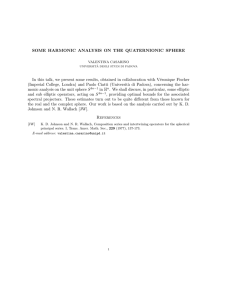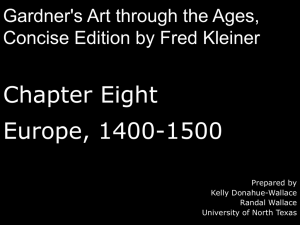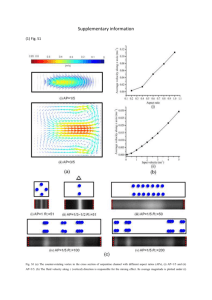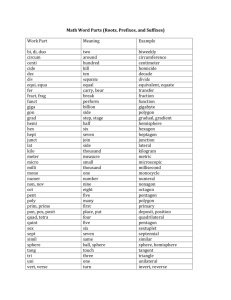XVIII. MICROWAVE THEORY E. F. Bolinder
advertisement
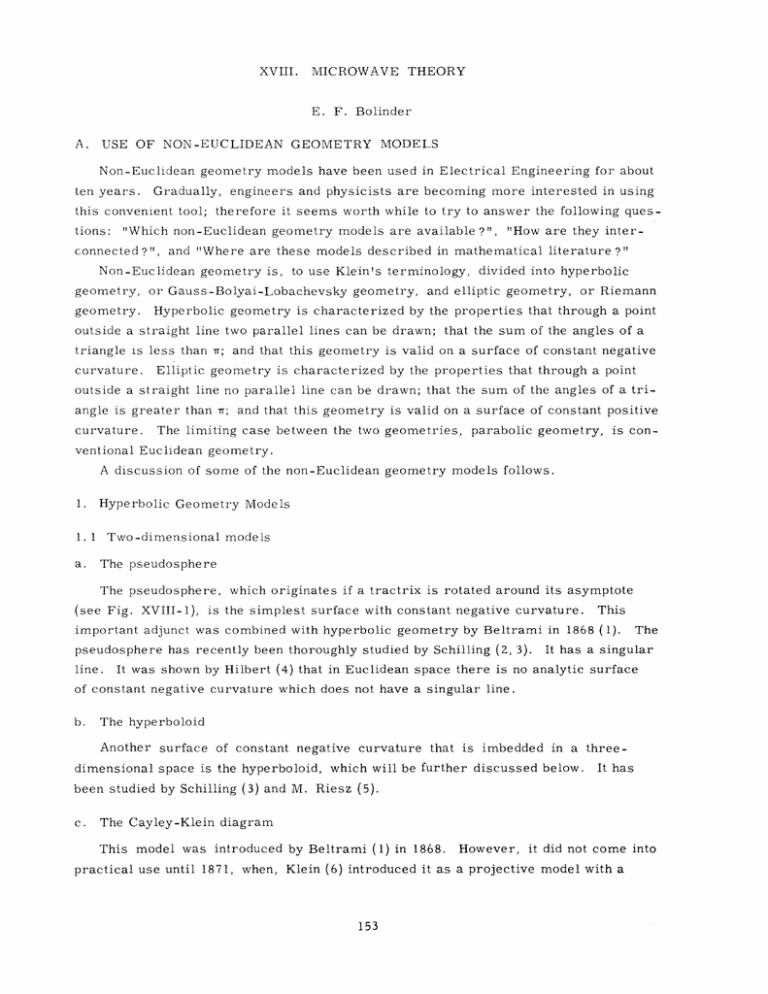
XVIII. MICROWAVE THEORY E. F. A. Bolinder USE OF NON-EUCLIDEAN GEOMETRY MODELS Non-Euclidean geometry models have been used in Electrical Engineering for about ten years. Gradually, engineers and physicists are becoming more interested in using this convenient tool; therefore it seems worth while to try to answer the following questions: "Which non-Euclidean geometry models are available ?", "How are they inter- connected ?", and "Where are these models described in mathematical literature ? " Non-Euclidean geometry is, to use Klein's terminology, divided into hyperbolic geometry, or Gauss-Bolyai-Lobachevsky geometry, and elliptic geometry, geometry. or Riemann Hyperbolic geometry is characterized by the properties that through a point outside a straight line two parallel lines can be drawn; that the sum of the angles of a triangle is less than r; and that this geometry is valid on a surface of constant negative curvature. Elliptic geometry is characterized by the properties that through a point outside a straight line no parallel line can be drawn; that the sum of the angles of a triangle is greater than rr; and that this geometry is valid on a surface of constant positive curvature. The limiting case between the two geometries, parabolic geometry, is con- ventional Euclidean geometry. A discussion of some of the non-Euclidean geometry models follows. 1. Hyperbolic Geometry Models 1. 1 Two-dimensional models a. The pseudosphere The pseudosphere, (see Fig. XVIII-1), which originates if a tractrix is rotated around its asymptote is the simplest surface with constant negative curvature. This important adjunct was combined with hyperbolic geometry by Beltrami in 1868 (1). pseudosphere has recently been thoroughly studied by Schilling (2, 3). line. The It has a singular It was shown by Hilbert (4) that in Euclidean space there is no analytic surface of constant negative curvature which does not have a singular line. b. The hyperboloid Another surface of constant negative curvature that is imbedded in a three- dimensional space is the hyperboloid, which will be further discussed below. It has been studied by Schilling (3) and M. Riesz (5). c. The Cayley-Klein diagram This model was introduced by Beltrami (1) in 1868. However, it did not come into practical use until 1871, when, Klein (6) introduced it as a projective model with a 153 (XVIII. MICROWAVE THEORY) conic as the absolute or fundamental curve. the model is usually called the "Cayley-Klein on the work of Cayley (7) and, therefore, diagram." Klein based his work, to a large extent, An example of this model is shown in Fig. XVIII-2. figure corresponds to the absolute curve (infinity). hyperbolic distance between two points, of the cross ratio between P 1 P 1 The unit circle in the A straight line is a chord. The and P 2 , is defined as half of the logarithm and P2 and the two points Pa and Pb that are cut out of the absolute curve by a straight line through P and P . 1 2 d. The Poincare model Although it was known to Beltrami (1), this model has been called after Poincare, because of his extensive use of it in his investigations on automorphic functions (8). Examples of this model are shown in Fig. XVIII-3 and Fig. XVIII-4. the unit circle is the absolute curve (infinity); In Fig. XVIII-3 in Fig. XVIII-4 it is a straight line. In both figures a straight line is represented by an arc of a circle which cuts the absolute curve orthogonally. Fig. XVIII-1. Tractrix. Fig. XVIII-2. Two-dimensional CayleyKlein model. Pbb Fig. XVIII-3. Two-dimensional Poincare model. Fig. XVIII-4. 154 Two-dimensional Poincare/ model. (XVIII. MICROWAVE THEORY) 1. 2 Three-dimensional models a. Hyperhyperboloid The hyperhyperboloid is imbedded in four dimensions, and therefore it is of little interest from a practical point of view. However, in many cases the calculations and constructions can be made in three dimensions and formally extended to four dimensions (5). b. The Cayley-Klein model This model is a direct generalization of the two-dimensional model to three dimen- sions. It has been thoroughly studied by Schilling (9), who, for simplicity, uses the (Riemann) unit sphere as an absolute surface. c. The Poincare model This model is a direct generalization of the two-dimensional model to three dimen- sions. 2. Elliptic Geometry Models 2. 1 Two-dimensional models a. The sphere The sphere is the simplest surface of constant positive curvature. However, the important assumption that two points on a diameter together form a single "point" has to be made in order that the sphere (hemisphere) constitute an ideal model of twodimensional elliptic geometry. b. The projective plane A central projection of the hemisphere on a plane parallel to the plane that limits the hemisphere and is tangent to it yields a model of elliptic geometry in the form of a one-sided projective plane. c. Closed surfaces Two closed surfaces without singularities were found by Boy (10) and Schilling (11). These surfaces possess all of the properties of the projective plane. 2. 2 Three-dimensional models a. The hypersphere The hypersphere is imbedded in four dimensions. 155 (XVIII. b. MICROWAVE THEORY) Three-dimensional elliptic space This space has been thoroughly studied by Schilling (12), c. among others. Two Riemann spheres An interesting model of three-dimensional elliptic space consists of two Riemann spheres imbedded in Euclidean space. quaternions. 3. The natural analytic tool to use is the theory of See the work of Study (13) and of others (14). Interconnections of the Non-Euclidean Geometry Models 3. 1 Two-dimensional models a. Geometric treatment Let us study a simple example, Z' = k 2 Z = e 2 Z, an ideal transformer transformation: (1) k = 2 If we use the well-known transformation, ' Z'+ 1 1' Z+ - 1 1 (2) where F' and F are complex reflection coefficients, Eq. 1 transforms into r cosh Y + sinh 5 5 r - 4 r, = F sinh + cosh 4 r 3 3 4 (3) + 54 If the complex-impedance plane, Z = R + jX, is stereographically mapped on the Riemann unit sphere, the reflection-coefficient plane, F = rz + j y, falls in the yz- plane, because it can easily be shown that Eq. 2 corresponds to a rotation of the projection center from (0, 0, 1) to (-1, 0, 0) on the sphere. In Fig. XVIII-5 the point Z = 1 corresponds to F = 0; and Z' = 4, which is obtained from Eq. 1, corresponds to The ideal transformer corresponds to a stretching (hyperbolic transformF'z = 0. 6. ation) of the surface of the sphere directed from the fixed point (0, 0, -1) toward the fixed point (0, 0, 1), so that (1, 0, 0) is transformed into (0.47, 0, 0. 88). We now consider a unit hyperboloid with the x-axis as the rotation axis. Fig. XVIII-5, therefore, we obtain a unit hyperbola. In M. Riesz (5) has shown that if, in Fig. XVIII-5, the point F' z = Pp, p which may be considered to lie in a two-dimensional Poincare model in the yz-plane, is stereographically projected on the hyperboloid from (-1, 0, 0) so that Ph is obtained, then a central line OPh cuts the vertical plane parallel to the yz-plane through (1, 0, 0) in PCK which may be considered a point of a twodimensional Cayley-Klein model. The Cayley-Klein diagram may also be obtained by an orthographic projection of the sphere on the same plane. 156 An orthographic projection (XVIII. MICROWAVE THEORY) P(1, 0,188) P ( 2.13,0, 1.88) P (1,0,1. 2) (.. )(047,0,0 88) r\ a %(ooo ,Pp Ph Pc KP2 SPs " (0,0, Fig. XVIII-5. 0,0-, - z848 e x R (1,0,0) )I Interconnections of different non-Euclidean models. of Ph on the same plane yields Pe, which can also be obtained by a central projection of P' s P' Therefore, . e may be considered as lying in an elliptic projective plane. Thus we have the hyperbolic Cayley-Klein model (PCK), the parabolic (Euclidean) plane (Pp), and the elliptic projective plane (Pe) coalescing in the same vertical plane. By Pe, and varying Z'(F') we obtain a geometric picture of how the points Ps' PCK' The example selected, Z = 1 - Z' = 4, Pj vary. b. is indicated by arrows in Fig. XVIII-5. Analytic treatment A point F in the F-plane (Poincare model) is S= z +jF y If F is expressed in tetracyclic coordinates (14), ex 4 x3 3 0x 2 = + = 1 - 2 2 +F z y 2 F2 z - 2 y = 2F ex 1 = 2F z 157 Pp' we obtain (XVIII. MICROWAVE THEORY) on thE unit (hemi) sphere is The point P 2r + F2 + zs 2 z y 2F y s 1+ 12 + z 2 y 2 S- 2 z x= + I s y 2 2 z y Ps is obtained by a stereographic projection on the sphere. The point PCK in the Cayley-Klein diagram is 2F zCK 2 2 = z s z y 2r FyCK - + y 2 + z 2 s y In homogeneous coordinates the point PCK is expressed as 1 +r (1 S2 r 2 1/2 1 -r z CK r2rzCK - 2 2 yCK) 2 CK1/2 - y -2 y I 1 x z x -r 1 -r z2 2y 2[ s zZs y 2 z s s s '-ry z The point Ph on the surface of the hyperboloid, w zz z 2 21 P ryCK (1 ,2 + X Ys x S 158 - z - y = 1, is xs S (XVIII. MICROWAVE THEORY) The transformation of Ph -- Ph on the hyperboloid is expressed as w1al z' b y' c 1 a2 a3 w b2 b3) z c 2 c3/ The transformation by the real 3 x 3 matrix belongs to the G+ subgroup of the proper Lorentz group. The point PCK in the Cayley-Klein diagram in homogeneous coordinates is (w' z' p The point P' ZI s on the sphere is s ZI wt (1 + Z'2 +y2 yI )1/2 yI Ys w' x' - 2 1/ (1 +z'2 + 1 s ' _ = ( 1 Z ( + y2 2 (1+z, W' 1/2 The point PCK in the Cayley-Klein model is = z' "' zCK s ryCK Ys The point 1 z' in the F-plane (Poincar6 model) is Z' z 1+ x 1 +x' zCK s yCK yl Ys y "' z' S s 1 +(1 +z' 2 + 2y,1/2 ) 1 +(1 - 2 zCK _ 2 yCK 1/2 The rather complicated procedure, which is presented above, for transforming S- r' was performed in order to show analytically how some of the two-dimensional non-Euclidean geometry models can be used. In the presentation we have proceeded 159 (XVIII. MICROWAVE THEORY) from the F-plane (Poincar" model) to the hyperboloid by means of the sphere and the Cayley-Klein model. Instead of the Cayley-Klein model we might just as well have used the elliptic projective plane. 3.2 Three-dimensional models The interconnections of the three-dimensional models can be shown by a direct generalization of the two-dimensional case. We start out with a point Q in three dimensions (Poincar6 model) which we express, 5 z =1-Q 4 a-x o-x 3 = 2Q 2 = o-x in pentaspheric coordinates: 2 2 2 + Qz + Qy + Qx x5 = ox this time, 2 z y -Q 2 _2 -Q y x x 2Q = 2Q z We proceed from the Poincar" model to the hyperhyperboloid by means of the hypersphere and either the three-dimensional Cayley-Klein model or the three-dimensional elliptic space. The transformation on the hyperhyperboloid is performed by a real 4 X 4 matrix which is the same matrix that was discussed in the Quarterly Progress Report of July 15, 1956, pages 83-85. While the two-dimensional models are suited for impedance transformations through lossless, bilateral, two terminal-pair networks, the three-dimensional models are equally suited to impedance transformations through lossy, bilateral, two terminal-pair networks. E. F. Bolinder References 1. E. Beltrami, Giorn. Mat. 6, 284-312 (1868); Opere Matematiche di E. Vol. I (Ulrico Hoepli, Milano, 1902), pp. 374-405. Beltrami, 2. F. Schilling, Die Pseudosphaire und die nichteuklidische Geometrie (B. G. Verlag, Leipzig and Berlin, 1935). 3. F. Schilling, Pseudospharische, hyperbolisch-sparische und elliptisch-spharische Geometrie (B. G. Teubner Verlag, Leipzig and Berlin, 1937). 4. D. Hilbert, Trans. Am. Math. Soc. 2, Teubner 87-99 (1901). o Kungl. Fysio- 5. M. Riesz, Lunds Univ. Arsskrift, N. F. Avd. 2, 38, No. 9 (1943); graf. Sillsk. Handl., N. F. 53, No. 9 (1943), 76 pp. (In Swedish). 6. F. Klein, Math. Ann. 4, 573-625 (1871); F. Klein Gesammelte Mathematische Abhandlungen. Herausgegeben von R. Fricke und A. Ostrowski, Vol. I (Springer Verlag, Berlin, 1921), pp. 254-305. 160 (XVIII. MICROWAVE THEORY) 7. A. Cayley, Trans. Roy. Soc. (London) 149, 61-90 (1859); The Collected Mathematical Papers of A. Cayley, Vol. II(Cambridge University Press, London, 1889), pp. 561-592. 8. H. Poincar6, Acta. Mat. 1, 1-62 (1882). 9. F. Schilling, Die Bewegungstheorie im nichteuklidischen hyperbolischen Raum, Vols. I, II(Leibniz-Verlag, Miinchen, 1948). Boy, Math. Ann. 57, 151-184 (1903). 10. W. 11. F. Schilling, Math. Ann. 92, 69-79 (1924). 12. F. Schilling, Die Bewegungstheorie im nichteuklidischen elliptischen Raum (Danzig, 1943). 13. E. Study, Am. J. Math. 29, 101-167 (1907). 14. F. Klein, Vorlesungen iiber h6here Geometrie. W. Blaschke (Springer Verlag, Berlin, 1926). B. Bearbeitet und herausgegeben von ELEMENTARY NETWORK THEORY FROM AN ADVANCED GEOMETRIC STANDPOINT In the early days of network theory two different methods of transforming imped- ances by the linear fractional transformation Z' aZ + b cZ + d' ad - bc = 1 (1) These methods were called the "iterative impedance method" and the were developed. "image impedance method." In the first method the input impedance Z' is expressed in the output impedance Z by the linear fractional transformation X Zfl e -X - Zf2 e- Zfl Zf2 X -e(2) (2) fl -Zf2e -X X - Zf2 e Zfle f2 +e f f2 Zf f2 Zfl -Zf2 Z' = X Z Zf where the iterative impedances Zfl and Zf 2 , the fixed points of the transformation, are expressed as fl Zf2 a -d [(a+d) ad[ - 41/2 ad - bc = 1 2c (3) and ek a + d-[(a+d) 2 2 (4) - 41/2 In the Quarterly Progress Report of April 15, 161 1956, pages 126-8, it was shown that (XVIII. Eq. 2, MICROWAVE THEORY) written in the canonic form =e f2 Z (5) - Zf2 can be interpreted as a spiral (loxodromic) motion of the surface of the unit Riemann sphere around an inner axis through the fixed points Zfl and Zf2. This motion can be split into a stretching and a rotation, given by the real part k'and the imaginary part X" of X, respectively. A similar geometric interpretation is valid for the image impedance method. that case Eq. 1 can be written: (Z I 1 1/2 Z cosh 8 For + sinh 0 (Z. Z) i 1 /2 Z' = (z Z)1/2 with Z (Z Z )1/2 (7) Z! 1 = (Z'o Z's)1/2 tanh 0 = (8) (8) Z 1/2 / 1/2 = 1 (9) where Z. and Z1 are the image impedances at the output and at the input, Z and Z' are open-circuit impedances, Z and Z' are short-circuit impedances, and 0 is the image S S propagation function, also called the "image transfer constant." A comparison of Eqs. 6 and 1 yields: Z = bd)l/2 z( )1/2 = (bc) 1 / 2 tanh (10) Let us study a simple example consisting of the unsymmetric resistive network shown in Fig. XVIII-6. The six impedances Zfl = 2, Zf2 = -1, Z = 3, Zs = 1, Z = -2, and Z s = -2/3 are stereographically mapped on the unit sphere (unit circle), as shown in Fig. XVIII-7. The sphere (circle) is considered as the absolute surface (curve) of a three- (two-) dimensional hyperbolic space with hyperbolic metric. In this space a hyperbolic distance is defined as half the logarithm of the cross ratio between the given points and the two points on the unit sphere (circle) which are cut out by a straight line through the given points. See, for example, references 1 and 2. Equations 7 and 8 yield simple constructions for the image impedances Z 162 i = 2 F/3 (XVIII. and Z'. = 1 former. See Fig. XVIII-7. . (-Z s ) 1 Z os From Eqs. /2 Equation 9 is essentially the equation for an ideal trans- the hyperbolic distances 6-os and o's' in Fig. XVIII-7 are equal; Therefore, here tanh 0 = F/3. MICROWAVE THEORY) (-Z' 7, 8, 9,3, and 1 Z )1/2 o = (Z Z1/2 i i we obtain = (-Z fl Z (= 2 f2 /l ) (10) ( must all pass through a point Z Z' Zo, (-Zi) Z, and Z fl f2 i1 s o f in Fig. XVIII-7, yielding, for example, a simple construction for finding Zo, when the lines Z Therefore, Z' S' Z', O' and Z s Z', 0 are known. S Equation 6 can be split as follows: Z! Z a = Z Z'= Zb - a c 1 sinh O/Z' + cosh 0 (1lb) Z (12a) 1 Z. 1 Z Z 8 + Z! sinh 0 cosh a Z (la) Z Z. i cosh 0 + sinh 0 (12b) Zb sinh 0 + cosh 0 Z' = Z! Z 1 (12c) C Z cosh 0 + Z. sinh 0 Zd = Z' (13a) Z sinh 0 /Z =Z i + cosh 0 Zd (13b) 1 Equations la, 12a, 12c, and 13b represent ideal transformers that correspond to hyperbolic transformations (stretchings) along the vertical axis through the fixed points zero and infinity. Equations 11b, 12b, and 13a represent symmetric networks (a=d) that correspond to hyperbolic transformations (a+d > 2) along horizontal axes through the fixed points ± Z!, ± 1, and ± Z. The equivalent networks corresponding to Eqs. 11, 12, and 13 are shown in Figs. XVIII-8a, XVIII-9a, and Fig. XVIII-10a. Finally, let us perform a transformation of the impedance Z = 0. 5 to Z' = 1.4 by the iterative impedance method and the image impedance method. point Z = 0 is transformed into Z' = Z' transformed into g in Fig. XVIII-7. We know that the so that, according to the first method, f is s 1 The hyperbolic distance fg is k' = In -. Therefore, Z' is obtained from Z by two perspectivities with f and 163 g as centers (1, 2). S Fig. XVIII-6. 2 Z Simple example of a resistive network. Zo Z z sZ Zf' Z 0 Fig. XVIII-7. Iterative impedance method. -/ .1 ,-3 2 Image impedance method. Example 1. Fig. XVIII-8. 3 -,12 3 -2 (a) Fig. XVIII-9. 3 FgI Image impedance method. k(. 0 -) f .9() 6 _I Ia (l) Fig. XVIII-10. Example 2. ' I Z, kd I (b) Image impedance method. 164 Example 3. (XVIII. MICROWAVE THEORY) Transformations by the image impedance method are shown in Figs. XVIII-8b, XVIII-9b, and XVIII-10b. f and i', i' According to Fig. XVIII-8a and b, Z - Z' by two perspectivities through corresponding to the ideal transformer, followed by two perspectivities through and g, corresponding to the symmetric network. From Fig. XVIII-9a and b, we obtain six perspectivities through m and s' (first ideal transformer), metric network = ideal reflection-coefficient transformer), ideal transformer). and s' s' and k (sym- and n (second From Fig. XVIII-10a and b, we obtain four perspectivities through i and 1 (symmetric network), and i and f (ideal transformer). work studied is symmetric, Zfl Z = Z and Zf = - Z, Obviously, if the netand the two methods coalesce. If the network is composed of both lossy and lossless components the geometric constructions have to be performed in three dimensions. E. F. Bolinder References 1. J. Van Slooten, Meetkundige Beschouwingen in Verband met de Theorie der Electrische Vierpolen (W. D. Meinema, Delft, 1946). 2. E. F. 1956. Bolinder, Acta Polytechnica, Electrical Engineering Series, Vol. 165 7, No. 5,
